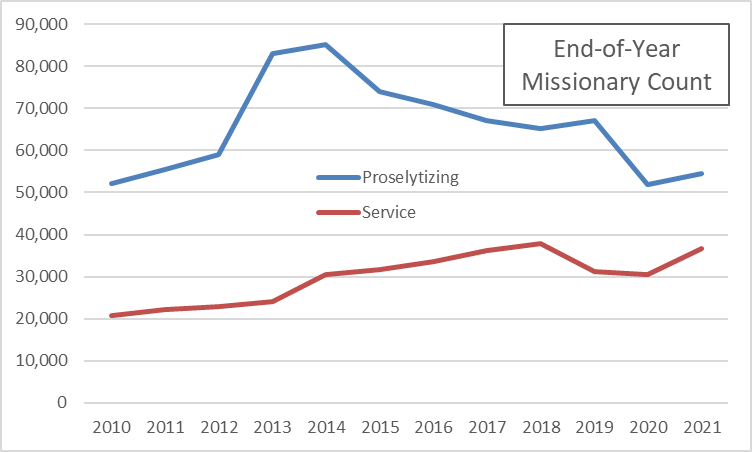It may not be read in general conference anymore, but needless to say, I was interested to take a look at the Church’s 2021 statistical report. One interesting thing I noticed has to do with the counts of proselytizing versus service missionaries. Here’s a graph showing the end-of-year counts of missionaries since 2010. You can see in the count of proselytizing missionaries the jump with the age change in 2012, the slow decline afterward, and then the dramatic drop with COVID and then some recovery. The count of service missionaries has had fewer dramatic movements, increasing through 2018, then declining for a couple of years, and then increasing sharply in 2021.

As I mentioned in my conference review post, several speakers reminded young men that they need to be serving missions, and that young women can go as well. For example, here’s President Nelson in the opening talk of the conference:
Today I reaffirm strongly that the Lord has asked every worthy, able young man to prepare for and serve a mission. For Latter-day Saint young men, missionary service is a priesthood responsibility. . . . For you young and able sisters, a mission is also a powerful, but optional, opportunity. . . . Your decision to serve a mission, whether a proselyting or a service mission, will bless you and many others. [italics in original]
As an aside, I find the patronizing tone directed toward young women grating, but I feel like at least it represents a step forward from President Hinckley’s 1997 talk where he pretty openly discouraged women from serving. Anecdotally, for some women I know who were missionaries at the time, the talk led many elders to sneer to them, “Why don’t you just go home?”
Looking back to the graph, President Nelson and the other GAs are clearly concerned with the upper line, the count of proselytizing missionaries. It fell from about 67,000 at the end of 2019 to about 52,000 at the end of 2020. Of course this can be attributed to the pandemic. But then through 2021, even as vaccines became more widely available, it rebounded only a little, to about 55,000. I suspect they’re concerned that all the disruption in missionary work because of COVID has made missionary service seem more optional.
